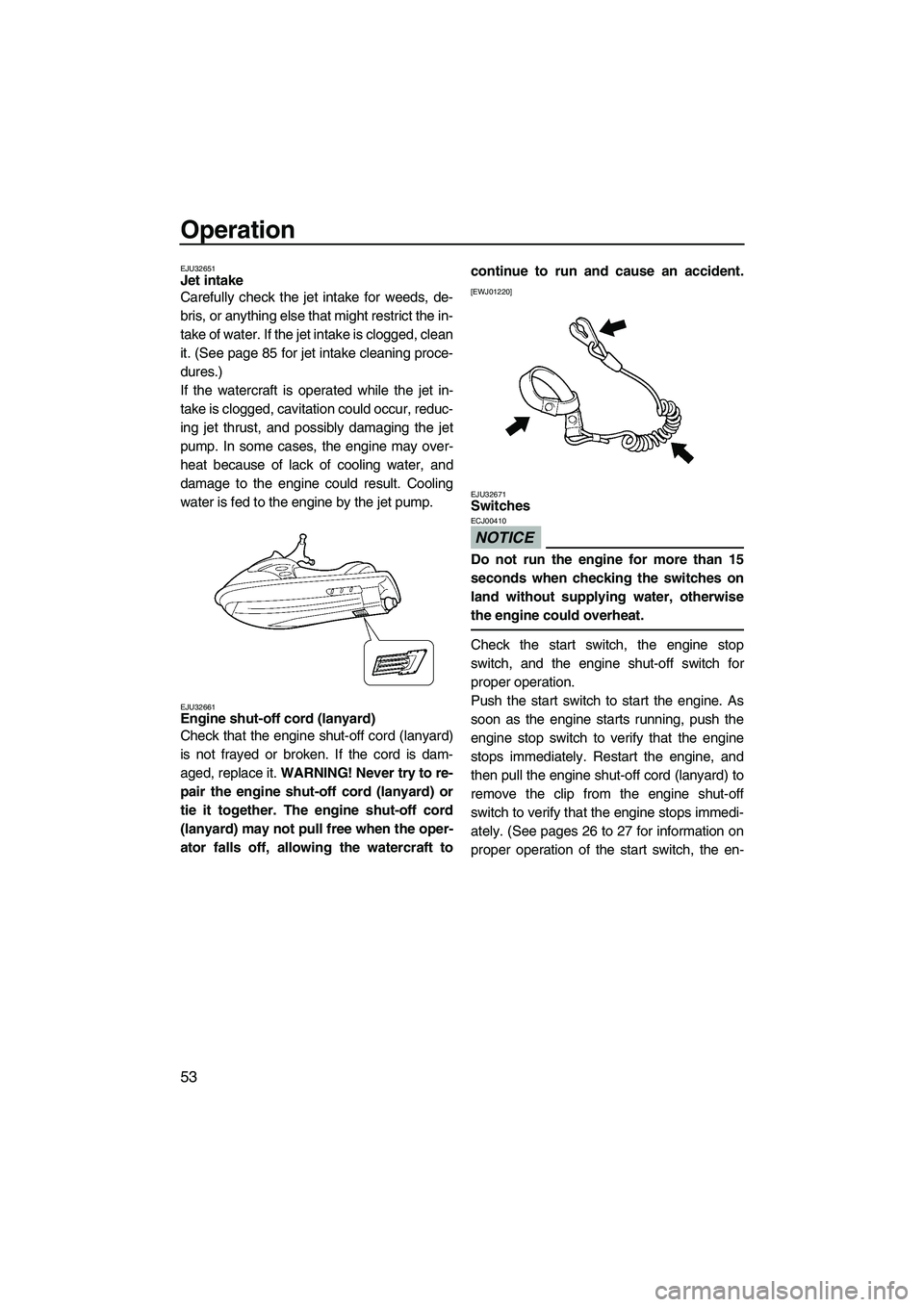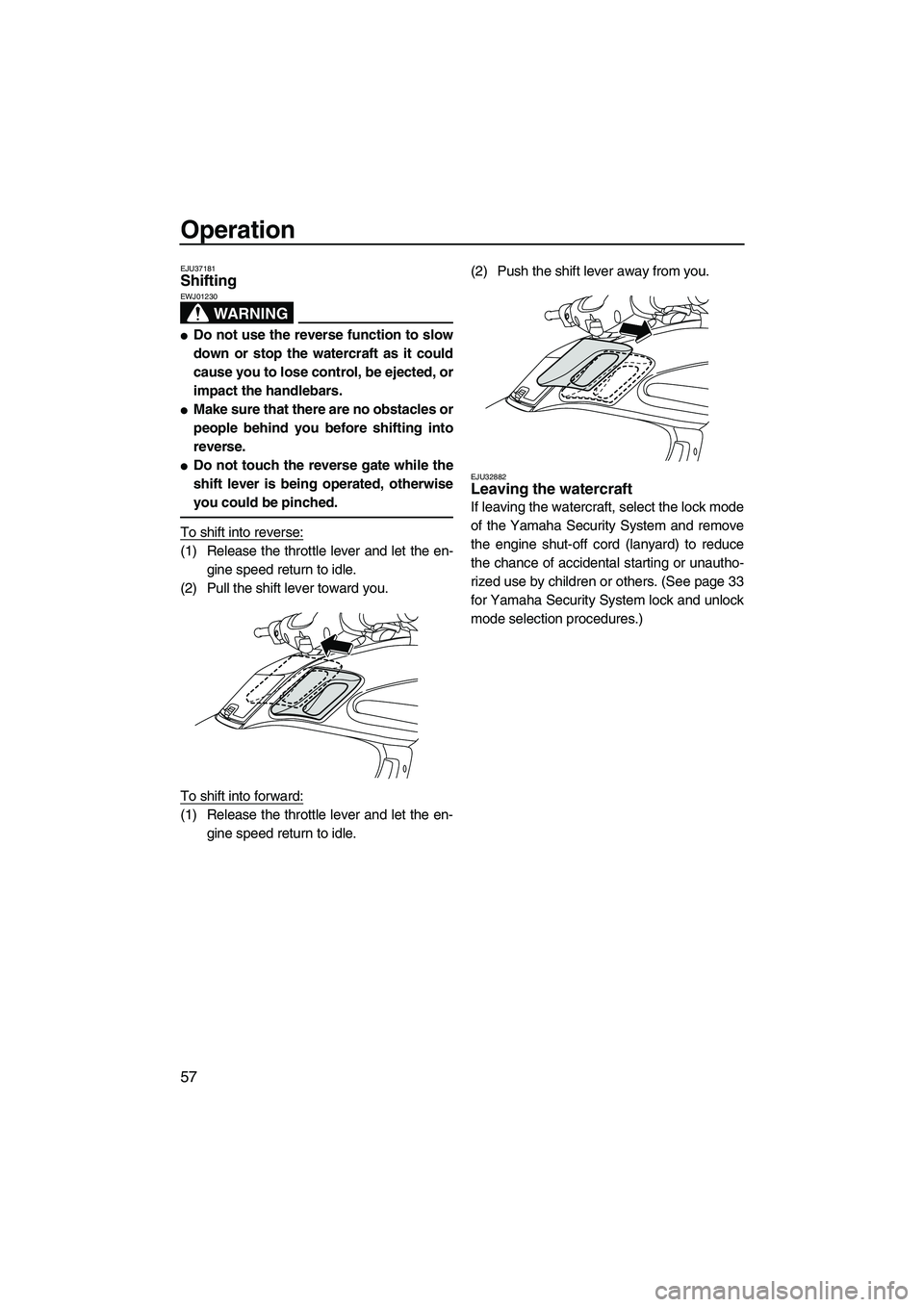Page 57 of 98

Operation
50
Recharge the battery or replace it if it is not in
good condition. (See page 78 for battery re-
charging procedures.)
Also, check that the battery leads are tight-
ened securely and that there is no corrosion
on the battery terminals. Check that the
breather hose is securely connected to the
battery and that it is not pinched. WARNING!
Fire or explosion could result if the breath-
er hose is damaged, obstructed, or not
connected properly.
[EWJ00451]
Make sure that the battery is securely held in
place.
EJU32541Fire extinguisher
Check that there is a full fire extinguisher on
board.
The fire extinguisher holder and cover are lo-
cated in the front storage compartment.To store the fire extinguisher, unhook the
band and remove the cover. Place the fire ex-
tinguisher in the holder, and then place the
cover over the fire extinguisher. Fasten the
cover and the fire extinguisher with the band
securely.
To check the fire extinguisher, see the instruc-
tions supplied by the fire extinguisher manu-
facturer. Always keep the fire extinguisher
secured in the holder with its cover in place.
Always carry a fire extinguisher on board. A
fire extinguisher is not standard equipment
with this watercraft. If you do not have one,
contact a Yamaha dealer or a fire extinguisher
dealer to obtain one meeting the proper spec-
ifications.
EJU32591Throttle lever
Check the throttle lever for proper operation.
Squeeze and release the throttle lever several
times to make sure that there is no hesitation
in its travel. It should be smooth over the com-
1Negative (–) battery terminal: Black lead
2Positive (+) battery terminal: Red lead
3Breather hose
12
3
1Fire extinguisher holder and cover
2Band
1
2
UF2C70E0.book Page 50 Monday, November 3, 2008 10:16 AM
Page 58 of 98
Operation
51
plete range and spring back to the idle posi-
tion when released.
EJU37390Steering system
Check the handlebars for looseness.
Turn the handlebars as far as possible to the
right and left to make sure that operation is
smooth and unrestricted throughout the
whole range. Also, make sure that the jet
thrust nozzle moves as the handlebars are
turned, and that there is no free play between
the handlebars and the jet thrust nozzle.
Pull the handlebars up and down to check that
the lock lever and handlebars are locked inplace. (See “Telescopic steering system” on
page 29 for more information.)EJU36581Shift lever and reverse gate
WARNING
EWJ00031
Do not touch the reverse gate while the
shift lever is being operated, otherwise
you could be pinched.
Check the shift lever and reverse gate for
proper operation.
Make sure that the reverse gate goes down
completely when the shift lever is pulled up.
1Lock lever
1
UF2C70E0.book Page 51 Monday, November 3, 2008 10:16 AM
Page 59 of 98
Operation
52
Also, make sure that the reverse gate goes up
completely when the shift lever is pushed
down.
EJU32641Quick Shift Trim System (QSTS)
Operate the QSTS selector lock lever and the
QSTS selector several times to check that
they operate properly.
(1) Squeeze the QSTS selector lock lever
and check that it returns smoothly to its
original position when released.(2) Check that the QSTS selector turns
smoothly when the lever is squeezed and
check that the selector locks in place at
each position when the lever is released.
(3) Check that the angle of the jet thrust noz-
zle changes when the QSTS selector is
shifted from neutral to bow up or bow
down.
If the mechanism does not work properly,
have a Yamaha dealer service it.
UF2C70E0.book Page 52 Monday, November 3, 2008 10:16 AM
Page 60 of 98

Operation
53
EJU32651Jet intake
Carefully check the jet intake for weeds, de-
bris, or anything else that might restrict the in-
take of water. If the jet intake is clogged, clean
it. (See page 85 for jet intake cleaning proce-
dures.)
If the watercraft is operated while the jet in-
take is clogged, cavitation could occur, reduc-
ing jet thrust, and possibly damaging the jet
pump. In some cases, the engine may over-
heat because of lack of cooling water, and
damage to the engine could result. Cooling
water is fed to the engine by the jet pump.
EJU32661Engine shut-off cord (lanyard)
Check that the engine shut-off cord (lanyard)
is not frayed or broken. If the cord is dam-
aged, replace it. WARNING! Never try to re-
pair the engine shut-off cord (lanyard) or
tie it together. The engine shut-off cord
(lanyard) may not pull free when the oper-
ator falls off, allowing the watercraft tocontinue to run and cause an accident.
[EWJ01220]
EJU32671
Switches
NOTICE
ECJ00410
Do not run the engine for more than 15
seconds when checking the switches on
land without supplying water, otherwise
the engine could overheat.
Check the start switch, the engine stop
switch, and the engine shut-off switch for
proper operation.
Push the start switch to start the engine. As
soon as the engine starts running, push the
engine stop switch to verify that the engine
stops immediately. Restart the engine, and
then pull the engine shut-off cord (lanyard) to
remove the clip from the engine shut-off
switch to verify that the engine stops immedi-
ately. (See pages 26 to 27 for information on
proper operation of the start switch, the en-
UF2C70E0.book Page 53 Monday, November 3, 2008 10:16 AM
Page 61 of 98
Operation
54
gine stop switch, and the engine shut-off
switch.)
EJU36890Cooling water pilot outlets
Check that water comes out from the port
(left) cooling water pilot outlets while the en-
gine is running and the watercraft is in the wa-
ter. (See page 28 for more information.)
EJU37450Dual analog meter unit
Check the dual analog meter unit for proper
operation while the watercraft is in the water.(See page 35 for information on proper oper-
ation of the dual analog meter unit.)
1Start switch
2Engine stop switch
3Engine shut-off switch
4Clip
5Engine shut-off cord (lanyard)
4
1 3
5
2
UF2C70E0.book Page 54 Monday, November 3, 2008 10:16 AM
Page 62 of 98

Operation
55
EJU32742
Operation
WARNING
EWJ00510
Before operating your watercraft, become
familiar with all of the controls. Consult a
Yamaha dealer about any control or func-
tion that you do not fully understand. Fail-
ure to understand how the controls work
could cause an accident or prevent you
from avoiding an accident.
NOTICE
ECJ00460
Make sure that the stern drain plugs are
tightened securely before launching the
watercraft.
EJU36661Engine break-in
NOTICE
ECJ00430
Failure to follow the engine break-in pro-
cedure could result in reduced engine life
or even severe engine damage.
The engine break-in period is essential to al-
low the various components of the engine to
wear and polish themselves to the correct op-
erating clearances. This ensures proper per-
formance and promotes longer component
life.
TIP:
Be sure to check the engine oil level before
operating the watercraft for the first time. (See
page 47 for engine oil checking procedures.)
(1) Launch the watercraft and start the en-
gine. (See page 55 for engine starting
procedures.)
(2) For the first 5 minutes, run the engine at
trolling speed only. For the 30 minutes of
operation after that, keep the engine
speed below 5000 r/min. For the 1 hour of
operation after that, keep the engine
speed below 6000 r/min.
(3) Proceed with normal operation.
EJU32801Launching the watercraft
When launching the watercraft, make sure
that there are no obstacles behind you.
Use the remote control transmitter to select
the unlock mode. (See page 33 for Yamaha
Security System lock and unlock mode selec-
tion procedures.)
After the watercraft is in the water, start the
engine. Shift into reverse and move the water-
craft back slowly. If there are waves, some-
one should make sure that the watercraft is
not pushed into the trailer before backing
away.
EJU36341Starting the engine
(1) If the lock mode of the Yamaha Security
System is selected, use the remote con-
trol transmitter to select the unlock mode.
(See page 33 for Yamaha Security Sys-
tem lock and unlock mode selection pro-
cedures.)
(2) Launch the watercraft in water free from
weeds and debris and at least 60 cm (2 ft)
deep from the bottom of the watercraft.
NOTICE: Never operate in water that is
less than 60 cm (2 ft) deep from the
bottom of the watercraft, otherwise
UF2C70E0.book Page 55 Monday, November 3, 2008 10:16 AM
Page 63 of 98
![YAMAHA FZS 2009 Owners Manual Operation
56
pebbles or sand could be sucked into
the jet intake, causing impeller dam-
age and engine overheating.
[ECJ00471]
(3) Attach the engine shut-off cord (lanyard)
to your left wrist, and th YAMAHA FZS 2009 Owners Manual Operation
56
pebbles or sand could be sucked into
the jet intake, causing impeller dam-
age and engine overheating.
[ECJ00471]
(3) Attach the engine shut-off cord (lanyard)
to your left wrist, and th](/manual-img/51/50223/w960_50223-62.png)
Operation
56
pebbles or sand could be sucked into
the jet intake, causing impeller dam-
age and engine overheating.
[ECJ00471]
(3) Attach the engine shut-off cord (lanyard)
to your left wrist, and then attach the clip
to the engine shut-off switch. It is not pos-
sible to start the engine with the clip re-
moved from the engine shut-off switch.
WARNING! Check that the engine
shut-off cord (lanyard) is attached cor-
rectly. If the engine shut-off cord (lan-
yard) is not attached correctly, it may
not pull free when the operator falls
off, allowing the watercraft to continue
to run and cause an accident.
[EWJ00581]
(4) Push the start switch (green button), and
then release it as soon as the engine
starts to run. If the engine does not startin 5 seconds, release the start switch,
wait 15 seconds, and then try again. The
engine will not start if the throttle lever is
squeezed. NOTICE: Never push the
start switch while the engine is run-
ning. Do not operate the start switch
for more than 5 seconds, otherwise
the battery will be discharged and the
engine will not start. Also, the starter
motor could be damaged.
[ECJ01040]
EJU32861
Stopping the engine
To stop the engine, release the throttle lever,
and then push the engine stop switch (red
button). WARNING! You need throttle to
steer. Shutting the engine off can cause
you to hit an obstacle you are attempting
to avoid. A collision could result in severe
injury or death.
[EWJ00601]
1Clip
2Engine shut-off switch
3Engine shut-off cord (lanyard)
31
2
UF2C70E0.book Page 56 Monday, November 3, 2008 10:16 AM
Page 64 of 98

Operation
57
EJU37181Shifting
WARNING
EWJ01230
�Do not use the reverse function to slow
down or stop the watercraft as it could
cause you to lose control, be ejected, or
impact the handlebars.
�Make sure that there are no obstacles or
people behind you before shifting into
reverse.
�Do not touch the reverse gate while the
shift lever is being operated, otherwise
you could be pinched.
To shift into reverse:
(1) Release the throttle lever and let the en-
gine speed return to idle.
(2) Pull the shift lever toward you.
To shift into forward:
(1) Release the throttle lever and let the en-
gine speed return to idle.(2) Push the shift lever away from you.
EJU32882Leaving the watercraft
If leaving the watercraft, select the lock mode
of the Yamaha Security System and remove
the engine shut-off cord (lanyard) to reduce
the chance of accidental starting or unautho-
rized use by children or others. (See page 33
for Yamaha Security System lock and unlock
mode selection procedures.)
UF2C70E0.book Page 57 Monday, November 3, 2008 10:16 AM